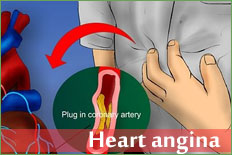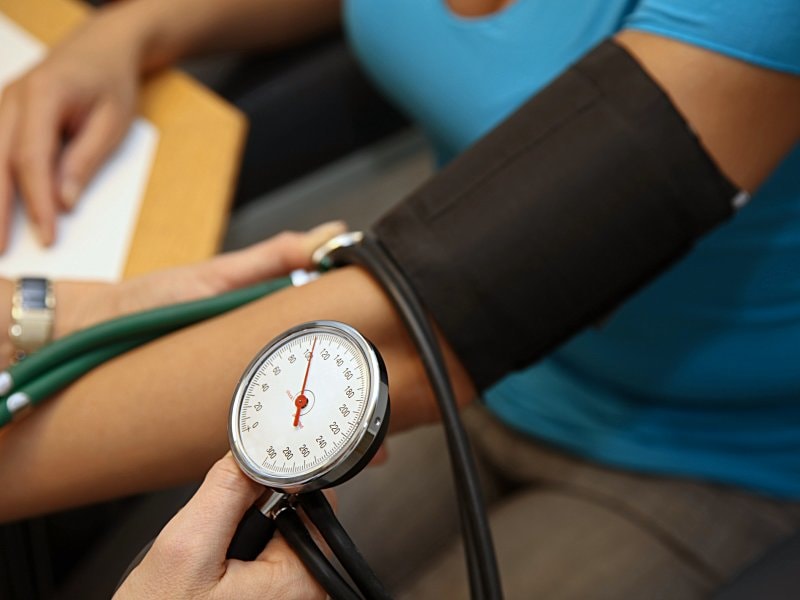Health Centers > Hypertension Health Center > Hypertensive Urgencies & Emergencies
Hypertensive Urgencies & Emergencies
Hypertensive emergencies have become less frequent in recent years but still require prompt recognition and aggressive but careful management. A spectrum of urgent presentations exists, and the appropriate therapeutic approach varies accordingly.
Systemic Hypertension - High Blood Pressure
- Introduction
L Prehypertension - Hypertension Etiology & Classification
L Primary (Essential) Hypertension
L Secondary Hypertension - Complications of Untreated Hypertension
- Hypertension symptoms and signs
- Goals of Hypertension Treatment
- Hypertension Nonpharmacologic Therapy
- Hypertension Drug Therapy
- Developing an Antihypertensive Regimen
- Special Considerations in the Treatment
- Hypertensive Urgencies & Emergencies
L Introduction
L Pharmacologic Management
Hypertensive urgencies are situations in which blood pressure must be reduced within a few hours. These include patients with asymptomatic severe hypertension (systolic blood pressure > 220 mm Hg or diastolic pressure > 125 mm Hg that persists after a period of observation) and those with optic disk edema, progressive target organ complications, and severe perioperative hypertension. Elevated blood pressure levels alone - in the absence of symptoms or new or progressive target organ damage - rarely require emergency therapy. Parenteral drug therapy is not usually required, and partial reduction of blood pressure with relief of symptoms is the goal.
Hypertensive emergencies require substantial reduction of blood pressure within 1 hour to avoid the risk of serious morbidity or death. Although blood pressure is usually strikingly elevated (diastolic pressure > 130 mm Hg), the correlation between pressure and end-organ damage is often poor. It is the latter that determines the seriousness of the emergency and the approach to treatment.
Emergencies include hypertensive encephalopathy (headache, irritability, confusion, and altered mental status due to cerebrovascular spasm), hypertensive nephropathy (hematuria, proteinuria, and progressive renal dysfunction due to arteriolar necrosis and intimal hyperplasia of the interlobular arteries), intracranial hemorrhage, aortic dissection, preeclampsia-eclampsia, pulmonary edema, unstable angina, or myocardial infarction. Malignant hypertension is by historical definition characterized by encephalopathy or nephropathy with accompanying papilledema. Progressive renal failure usually ensues if treatment is not provided. The therapeutic approach is identical to that used with other antihypertensive emergencies.
Parenteral therapy is indicated in most hypertensive emergencies, especially if encephalopathy is present. The initial goal in hypertensive emergencies is to reduce the pressure by no more than 25% (within minutes to 1 or 2 hours) and then toward a level of 160/100 mm Hg within 2-6 hours. Excessive reductions in pressure may precipitate coronary, cerebral, or renal ischemia. To avoid such declines, the use of agents that have a predictable, dose-dependent, transient, and not precipitous antihypertensive effect is preferable. In that regard, the use of sublingual or oral fast-acting nifedipine preparations is best avoided.
Acute ischemic stroke is often associated with marked elevation of blood pressure, which will usually fall spontaneously. In such cases, antihypertensives should only be used if the blood pressure exceeds 220/120 mm Hg, and blood pressure should be reduced cautiously by 10-15%. If thrombolytics are to be given, blood pressure should be maintained at < 185/110 mm Hg during treatment and for 24 hours following treatment.
In hemorrhagic stroke, the aim is to minimize bleeding with a target mean arterial pressure of < 130 mm Hg. In acute subarachnoid hemorrhage, as long as the bleeding source remains uncorrected, a compromise must be struck between preventing further bleeding and maintaining cerebral perfusion in the face of cerebral vasospasm.
In this situation, blood pressure goals depend on the patient's usual blood pressure. In normotensive patients, the target should be a systolic blood pressure of 110-120 mm Hg; in hypertensive patients, blood pressure should be treated to 20% below baseline pressure. In the treatment of hypertensive emergencies complicated by (or precipitated by) central nervous system injury, labetalol or nicardipine are good choices, since they are nonsedating and do not cause significant cerebral vasodilation, which can increase intracranial pressure (a potential problem with sodium nitroprusside). In hypertensive emergencies arising from catecholaminergic mechanisms, such as pheochromocytoma or cocaine use, β-blockers can worsen the hypertension because of unopposed peripheral vasoconstriction; phentolamine is a better choice. Labetalol is useful in these patients if the heart rate must be controlled.
Pharmacologic Management
A. PARENTERAL AGENTS
A growing number of agents are available for management of acute hypertensive problems. (Table 11-12 lists drugs, dosages, and adverse effects.) Sodium nitroprusside is the agent of choice for the most serious emergencies because of its rapid and easily controllable action, but continuous monitoring is essential when this agent is used. In the presence of myocardial ischemia, intravenous nitroglycerin or an intravenous β-blocker, such as labetalol or esmolol, is preferable.
1. Nitroprusside sodium - This agent is given by controlled intravenous infusion gradually titrated to the desired effect. It lowers the blood pressure within seconds by direct arteriolar and venous dilation. Monitoring with an intra-arterial line avoids hypotension. Nitroprusside - in combination with a β-blocker - is especially useful in patients with aortic dissection.
2. Nitroglycerin, intravenous - This agent is a less potent antihypertensive than nitroprusside and should be reserved for patients with accompanying acute ischemic syndromes.
3. Labetalol - This combined β- and α-blocking agent is the most potent adrenergic blocker for rapid blood pressure reduction. Other β-blockers are far less potent. Excessive blood pressure drops are unusual. Experience with this agent in hypertensive syndromes associated with pregnancy has been favorable.
4. Esmolol - This rapidly acting β-blocker is approved only for treatment of supraventricular tachycardia but is often used for lowering blood pressure. It is less potent than labetalol and should be reserved for patients in whom there is particular concern about serious adverse events related to β-blockers.
5. Nicardipine - Intravenous nicardipine is the most potent antihypertensive agent and the longest acting of the parenteral calcium channel blockers. As a primarily arterial vasodilator, it has the potential to precipitate reflex tachycardia, and for that reason it should not be used without a β-blocker in patients with coronary artery disease.
6. Fenoldopam - Fenoldopam is a peripheral dopamine-1 (DA1) receptor agonist that causes a dose-dependent reduction in arterial pressure without evidence of tolerance, rebound, or withdrawal or deterioration of renal function. In higher dosage ranges, tachycardia may occur.
7. Enalaprilat - This is the active form of the oral ACE inhibitor enalapril. The onset of action is usually within 15 minutes, but the peak effect may be delayed for up to 6 hours. Thus, enalaprilat is used primarily as an adjunctive agent.
8. Diazoxide - Diazoxide acts promptly as a vasodilator without decreasing renal blood flow. To avoid hypotension, it should be given in small boluses or as an infusion rather than as the previously recommended large bolus. One use of diazoxide has been in preeclampsia-eclampsia. Hyperglycemia and sodium and water retention may occur. The drug should be used only for short periods and is best combined with a loop diuretic.
9. Hydralazine - Hydralazine can be given intravenously or intramuscularly, but its effect is less predictable than that of other drugs in this group. It produces reflex tachycardia and should not be given without β-blockers in patients with possible coronary disease or aortic dissection. Hydralazine is now used primarily in pregnancy and in children, but even in these situations, newer agents are supplanting it.
10. Trimethaphan - The ganglionic blocking agent trimethaphan is titrated with the patient sitting; its activity depends on this. The patient can be placed supine if the hypotensive effect is excessive. The effect occurs within a few minutes and persists for the duration of the infusion. This agent has largely been replaced by nitroprusside and newer medications.
11. Diuretics - Intravenous loop diuretics can be very helpful when the patient has signs of heart failure or fluid retention, but the onset of their hypotensive response is slow, making them an adjunct rather than a primary agent for hypertensive emergencies. Low dosages should be used initially (furosemide, 20 mg or bumetanide, 0.5 mg). They facilitate the response to vasodilators, which often stimulate fluid retention.
B. ORAL AGENTS
Patients with less severe acute hypertensive syndromes can often be treated with oral therapy. Abrupt blood pressure lowering is not usually necessary in asymptomatic individuals, and the use of agents such as rapid-acting nifedipine probably causes more adverse effects than benefits.
1. Clonidine - Clonidine, 0.2 mg orally initially, followed by 0.1 mg every hour to a total of 0.8 mg, will usually lower blood pressure over a period of several hours. Sedation is frequent, and rebound hypertension may occur if the drug is stopped.
2. Captopril - Captopril, 12.5-25 mg orally, will also lower blood pressure in 15-30 minutes. The response is variable and may be excessive.
3. Nifedipine - Fast-acting nifedipine capsules are commonly used in the emergency department or urgent care setting because they usually provide a rapid reduction in blood pressure. However, the nifedipine effect is unpredictable and may be excessive, resulting in hypotension and reflex tachycardia. Because myocardial infarction and stroke have been reported in this setting, the use of nifedipine without concomitant β-blocker therapy is not advised.
C. SUBSEQUENT THERAPY
When the blood pressure has been brought under control, combinations of oral antihypertensive agents can be added as parenteral drugs are tapered off over a period of 2-3 days. Most subsequent regimens should include a diuretic.
Bibliography
Cherney D et al: Management of patients with hypertensive urgencies and emergencies. J Gen Intern Med 2002;17:947.
Devlin JW et al: Fenoldopam versus nitroprusside for the treatment of hypertensive emergency. Ann Pharmacother 2004; 38:755.
Khanna A et al: Malignant hypertension presenting as hemolysis, thrombocytopenia, and renal failure. Rev Cardiovasc Med 2003;4:255.
Migneco A et al: Hypertensive crises: diagnosis and management in the emergency room. Eur Rev Med Pharmacol Sci 2004; 8:143.
Phillips RA et al: Hypertensive emergencies: diagnosis and management. Prog Cardiovasc Dis 2002;45:33.


